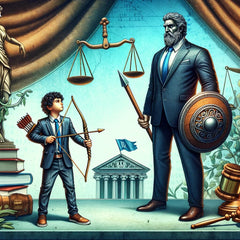Your cart is empty now.

Trademark vs Copyright - what are the differences?
- 20 April, 2024
- Nyall Engfield
Exploring the Nuances: Trademark vs. Copyright
In Intellectual property law, trademarks and copyrights are two distinct but equally important forms of protection. While both serve to safeguard creators' rights and interests, they apply to different types of assets and offer distinct sets of benefits and protections. This article delves into the fundamental differences between trademarks and copyrights, exploring their unique characteristics, scope of protection, and application in various creative and commercial contexts.
-
Definitions and Scope:
- Trademark: A trademark is a recognizable sign, design, or expression that identifies products or services of a particular source, distinguishing them from those of others. It can include words, logos, symbols, sounds, and even scents or colors. Trademarks serve as indicators of origin and help consumers identify and differentiate brands in the marketplace.
- Copyright: Copyright, on the other hand, protects original works of authorship fixed in a tangible medium of expression. This encompasses literary, artistic, musical, and dramatic works, as well as other creative endeavors such as software code, architectural designs, and choreographic works. Copyright grants creators exclusive rights to reproduce, distribute, perform, display, and create derivative works based on their creations.
-
Subject Matter:
- Trademark: Trademarks primarily apply to branding elements used in commerce, such as brand names, logos, slogans, and product packaging. They focus on identifying the source of goods or services and establishing brand recognition and reputation.
- Copyright: Copyright protects the expression of creative ideas and original works across a broad spectrum of mediums. This includes literary works (e.g., books, articles), visual arts (e.g., paintings, photographs), audiovisual works (e.g., films, videos), and musical compositions, among others.
-
Creation and Registration:
- Trademark: While the use of a trademark in commerce can establish certain rights, registration with the appropriate intellectual property office provides additional legal benefits and protections. Trademark registration involves filing an application and demonstrating the trademark's distinctiveness, as well as its use in commerce or an intent to use.
- Copyright: Copyright protection automatically applies to original works upon their creation and fixation in a tangible form. Registration with the copyright office is not required to establish copyright ownership, but it provides important benefits, such as the ability to bring a lawsuit for infringement and claim statutory damages.
-
Duration of Protection:
- Trademark: Trademark protection can potentially last indefinitely, as long as the mark remains in use and is properly maintained. Registration with intellectual property offices typically grants protection for a renewable period of 10 years, with the option to renew indefinitely as long as the mark continues to be used in commerce.
- Copyright: Copyright protection generally lasts for the life of the author plus an additional 70 years after the author's death. For works created by corporations or works with anonymous or pseudonymous authors, copyright protection typically lasts for 95 years from the date of publication or 120 years from the date of creation, whichever is shorter.
-
Rights and Enforcement:
- Trademark: Trademark rights grant owners the exclusive use of the mark in connection with specific goods or services. Trademark infringement occurs when another party uses a similar mark in a way that is likely to cause confusion among consumers. Trademark owners can enforce their rights through litigation, cease-and-desist letters, and administrative proceedings such as trademark oppositions and cancellations.
- Copyright: Copyright owners have the exclusive right to reproduce, distribute, perform, display, and create derivative works based on their copyrighted works. Copyright infringement occurs when someone else copies or uses the copyrighted work without authorization. Copyright owners can enforce their rights through legal action, seeking injunctions, damages, and other remedies for infringement.
-
Fair Use and Limitations:
- Trademark: Trademark law does not explicitly provide for a fair use doctrine like copyright law. However, certain fair use defenses may apply in limited circumstances, such as comparative advertising or commentary.
- Copyright: Copyright law includes a fair use doctrine, which allows for the limited use of copyrighted works without permission for purposes such as criticism, commentary, news reporting, teaching, scholarship, and research. Fair use is determined on a case-by-case basis, considering factors such as the purpose and character of the use, the nature of the copyrighted work, the amount and substantiality of the portion used, and the effect on the potential market for the work.
-
International Protection:
- Trademark: Trademark rights are territorial and generally apply within the jurisdiction where the mark is registered or used in commerce. However, some international treaties, such as the Madrid Protocol and the Paris Convention, facilitate the protection of trademarks across multiple countries through centralized registration and mutual recognition.
- Copyright: Copyright protection is also territorial, but international agreements such as the Berne Convention establish minimum standards of protection for copyright works among member countries. Additionally, the World Intellectual Property Organization (WIPO) administers treaties and systems for international copyright registration and enforcement.
In conclusion, trademarks and copyrights represent distinct forms of intellectual property protection, each tailored to different types of creative and commercial assets. While trademarks focus on brand identity and consumer recognition in commerce, copyrights safeguard the expression of original works across various artistic and literary mediums. Understanding the differences between trademarks and copyrights is essential for creators, businesses, and legal practitioners alike, as it enables them to navigate the complexities of intellectual property law and maximize the value and protection of their creative assets.



